Henry J. Kaiser-class replenishment oiler
The Henry J. Kaiser class is an American class of eighteen fleet replenishment oilers which began construction in August 1984. The class comprises fifteen oilers which are operated by Military Sealift Command to provide underway replenishment of fuel to United States Navy combat ships and jet fuel for aircraft aboard aircraft carriers at sea.[3] One ship, operated by the United States from 1987 to 1996, was sold to Chile in 2009 and commissioned into the Chilean Navy in 2010; and two ships were scrapped in 2011 while still incomplete.
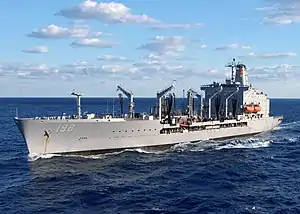 | |
| Class overview | |
|---|---|
| Name: | Henry J. Kaiser class |
| Builders: |
|
| Preceded by: | Cimarron-class |
| Succeeded by: | John Lewis-class |
| Built: | August 1984-May 1996 |
| In service: | December 1986-present |
| Planned: | 18 |
| Building: | 0 |
| Completed: | 16 |
| Cancelled: | 2 (both laid up incomplete) |
| Active: | 15 US, 1 Chile as of 1 March 2011 |
| Laid up: | 2 as of 1 March 2011 (incomplete ships) |
| Lost: | 0 |
| Retired: | 0 |
| General characteristics | |
| Type: | Fleet replenishment oiler |
| Tonnage: | 31,200 DWT |
| Displacement: |
|
| Length: | 677 ft (206.3 m) |
| Beam: | 97 ft 5 in (29.7 m) |
| Draft: | 35 ft (10.7 m) maximum |
| Installed power: |
|
| Propulsion: | Two medium-speed Colt-Pielstick PC4-2/2 10V-570 diesel engines, two shafts, cp propellers |
| Speed: | 20 knots (37 km/h) |
| Capacity: |
|
| Complement: | 66 to 89 civilian personnel and 7 to 24 U.S. Navy personnel |
| Sensors and processing systems: | 2 x AN/SPS-59 LN-66 surface search radars |
| Electronic warfare & decoys: | AN/SLQ-25 Nixie Torpedo Countermeasures[1] |
| Armament: |
|
| Aviation facilities: | Helicopter landing platform |
| Notes: |
|
Twelve of the Kaisers are not double-hulled like most modern tankers; the class will be replaced under the TAO(X) project which will build 20 double-hulled ships, starting with USNS John Lewis and USNS Harvey Milk.[4]
Technical overview
There are stations on both sides of each ship for underway replenishment of fuel and stores. The ships in this class have a small capacity to carry and transfer fresh and frozen foods as well as other materials, and have two dry cargo transfer rigs.
Patuxent, Laramie, and Rappahannock differ from the other 15 ships in having double hulls to meet the requirements of the Oil Pollution Act of 1990. Hull separation is 6 feet (1.8 m) at the sides and 6 feet 6 inches (1.98 m) on the bottom; this resulted in a 12% reduction in cargo capacity.
Construction program
The circumstances of the construction program were convoluted and it is worthwhile to spell them out here. The original contract, for T-AO 187, was awarded to Avondale Industries, (Avondale), on November 12, 1982: this contract included options for T-AOs 188, 189 and 190, which were exercised on January 20, 1983, (T-AO 188) and November 22, 1983, (T-AOs 189 and 190). A second-source contract, for T-AOs 191 and 192, was awarded to Pennsylvania Shipbuilding Company, (Penn Ship), on May 6, 1985. This contract included options for T-AOs 194 and 196, which were never exercised: after Penn Ship began to have cash flow problems, the Navy transferred these options from Penn Ship's contract to Avondale's contract and exercised them on June 16, 1988. Additional options on Avondale's contract were executed on June 28, 1985, for T-AO 193, on February 27, 1986, for T-AO 195; on February 12, 1987, for T-AO 197; on June 20, 1988, for T-AO 198; on October 6, 1988, for T-AOs 200, 202 and 204; and on March 24, 1989, for T-AOs 199, 201 and 203.
The Navy's contract with Penn Ship for T-AOs 191 and 192 was terminated before the ships were complete and a new contract was executed with Tampa Shipyards, Inc., of Tampa FL, a division of the American Ship Building Company. (Note that this company should not be confused with Tampa Shipbuilding Company, (TASCO), which was a totally different entity, at a different location, long gone by 1989.) Disputes over corrective construction and materials costs between the U.S. Navy and Tampa Shipyards resulted in termination of this contract in 1993, when T-AO 191 was said to be 95% complete and T-AO 192 84% complete. The Navy then determined that the ships were no longer needed as oilers, and undertook a study of the feasibility of converting them to ammunition ships. This study concluded that such a conversion was cost-prohibitive and the ships were placed in long-term storage in an incomplete condition. They were sold for recycling in 2011.
Naming
The class is named for its lead unit, Henry J. Kaiser, which in turn is named for the American industrialist and shipbuilder Henry J. Kaiser (1882–1967). The first nine ships were named for American shipbuilders, inventors, naval architects, and aeronautical engineers who played important roles in the history of the U.S. Navy. The tenth through eighteenth ships were named after American rivers, which is a more traditional naming convention for U.S. Navy oilers.
Operations
In U.S. Navy service, the ships serve in a non-commissioned status in the Military Sealift Command, with primarily civilian crews. After joining the fleet, the 16 completed ships all saw active service between 1986 and 1996, when Andrew J. Higgins became the first unit of the class to be laid up. Since then, some of the others have also spent periods out of service in reserve or in a limited operational status.
Foreign transfer
Andrew J. Higgins never re-entered U.S. service after being laid up in 1996. She was sold to Chile in 2009 and was commissioned into the Chilean Navy in 2010 as Almirante Montt.
Ships
| Photo | Ship | Hull No. | Status | Years Active | NVR Page |
|---|---|---|---|---|---|
 | Henry J. Kaiser | T-AO-187 | Active—Southern California Duty Oiler | 1986–present | AO187 |
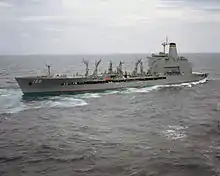 | Joshua Humphreys | T-AO-188 | Inactivated 1996, returned to service 2005 | 1987-1996; 2005-2006; 2010-present | AO188 |
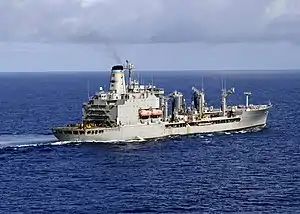 | John Lenthall | T-AO-189 | Active | 1987-1996; 1998–present | AO189 |
_underway_in_the_Gulf_of_Mexico_on_15_September_1987_(6429266).jpeg.webp) | Andrew J. Higgins | T-AO-190 | Inactivated May 1996. Sold to the Chilean Navy May 2009. Towed to Atlantic Marine Alabama shipyard, Mobile, Alabama, September 2009 for three-month refit. Commissioned in Chilean Navy on 10 February 2010 and renamed Almirante Montt. | 1987-1996 (USA); 2010–present (Chile) | AO190 |
.jpg.webp) | Benjamin Isherwood | T-AO-191 | Cancelled when 95.3% complete, transferred to the Maritime Administration, laid up in the James River Reserve Fleet, scrapped in 2011 | Launched 1988, christened 1991, never in service | AO191 |
.jpg.webp) | Henry Eckford | T-AO-192 | Cancelled when 84% complete, transferred to the Maritime Administration, laid up in the James River Reserve Fleet, scrapped in 2011 | Launched 1989, never in service | AO192 |
 | Walter S. Diehl | T-AO-193 | Active | 1988–present | AO193 |
_and_USNS_John_Ericsson_(T-AO-194).jpg.webp) | John Ericsson | T-AO-194 | Active | 1991–present | AO194 |
 | Leroy Grumman | T-AO-195 | Active | 1989–present | AO195 |
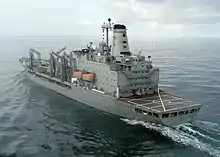 | Kanawha | T-AO-196 | Active | 1991–present | AO196 |
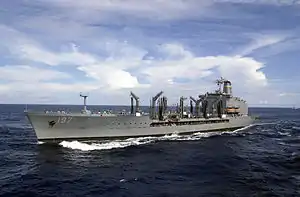 | Pecos | T-AO-197 | Active | 1990–present | AO197 |
 | Big Horn | T-AO-198 | Active | 1992–present | AO198 |
 | Tippecanoe | T-AO-199 | Active | 1993–present | AO199 |
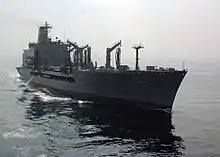 | Guadalupe | T-AO-200 | Active | 1992–present | AO200 |
 | Patuxent | T-AO-201 | Active | 1995–present | AO201 |
_oiler_USNS_Yukon_(T-A0_202)_prepares_for_a_replenishment-at-sea_(RAS)_with_USS_Kitty_Hawk_(CV_63)_in_a_turbulent_western_Pacific_Ocean.jpg.webp) | Yukon | T-AO-202 | Active | 1994–present | AO202 |
 | Laramie | T-AO-203 | Active | 1996–present | AO203 |
 | Rappahannock | T-AO-204 | Active | 1995–present | AO204 |
References
- "SLQ-25A/B (NIXIE) - Archive 7/2005". www.forecastinternational.com. Retrieved 19 October 2017.
- "T-AO-187 Kaiser Class - Archived 7/99". www.forecastinternational.com. Retrieved 19 October 2017.
The electronics consist of two LN-66 radar units, a commercial fathometer and an SLQ-25 NIXIE torpedo decoy. They have space and weight reserved to mount two Mark 15 Phalanx close-in weapons systems when required.
- "FLEET REPLENISHMENT OILERS - T-AO". www.navy.mil. US Navy. Retrieved 19 October 2017.
- Ronald O'Rourke. "Navy John Lewis (TAO-205) Class Oiler Shipbuilding Program: Background and Issues for Congress" (PDF). fas.org. Retrieved 19 October 2017.
External links
| Wikimedia Commons has media related to Henry J. Kaiser class oilers. |